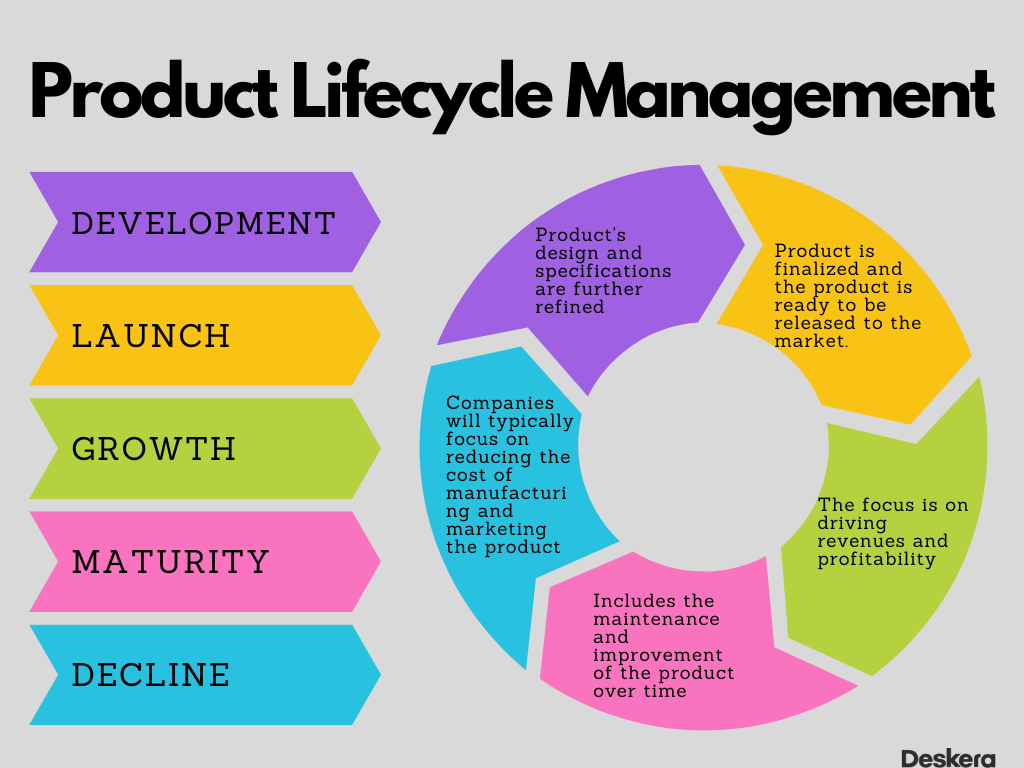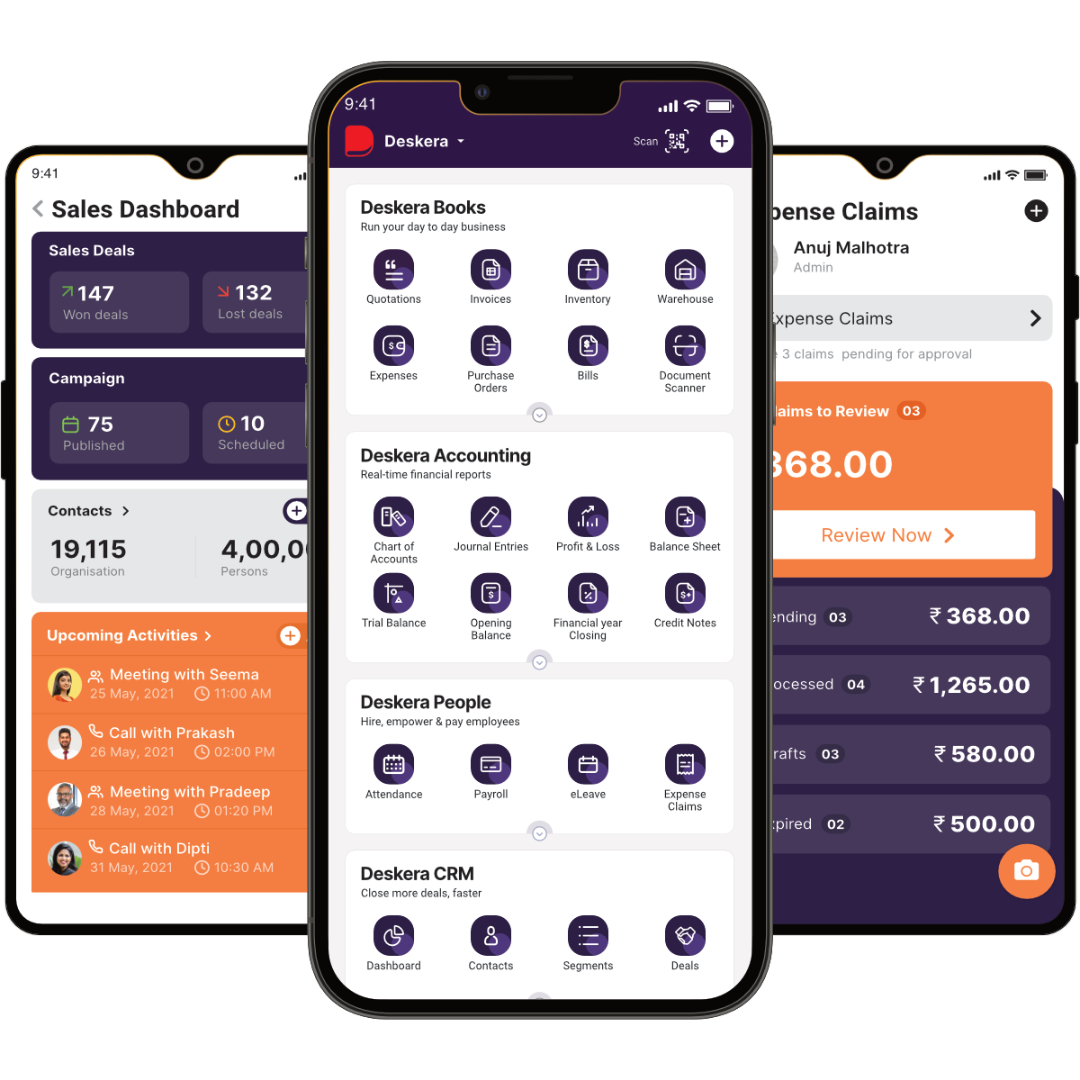Good product lifecycle management can reduce the number of design changes during product development by up to 70%.
That explains the significance of having adept product lifecycle management. Product Lifecycle Management (PLM) is a critical process for businesses that want to stay competitive in today's ever-changing market.
By understanding and managing the entire production cycle, from conception to end-of-life, businesses can ensure they are producing the most efficient and cost-effective products possible.

In this article, we will explore the benefits of PLM and how it can help businesses gain a competitive edge.
- What is Product Lifecycle Management?
- Benefits of Product Lifecycle Management
- Overview of the Product Development Process
- Key Elements of Product Lifecycle Management
- How Does Product Lifecycle Management Work?
- Challenges of Product Lifecycle Management
- Conclusion
- How can Deskera Help You?
- Key Takeaways
- Related Articles
What is Product Lifecycle Management?
Product Lifecycle Management (PLM) is an integrated approach to managing the entire lifecycle of a product from its conception and design to manufacturing, distribution, and, ultimately, disposal.
It is a process of managing the entire product lifecycle and the associated information, data, and processes that support it. This includes product design, development, testing, manufacturing, sales, and after-sales support. PLM is used to ensure that all stakeholders involved in the product lifecycle have access to the same information, allowing for improved communication and collaboration.
Benefits of Product Lifecycle Management
There are ample reasons why organizations seek to implement an exceptional PLM. Companies implement PLM because it helps them to reduce costs, improve quality, and increase speed to market.
PLM also improves collaboration between departments and enhances customer satisfaction by giving them visibility into the product’s progress. PLM can also help companies to create more innovative products, reduce time to market, and improve product safety and compliance.
Let’s look at the benefits of having product lifecycle management:
Improved Collaboration
Product lifecycle management (PLM) provides a single source of information for product teams, enabling them to collaborate more effectively throughout the entire product design, development, and launch process.
Increased Efficiency
PLM helps streamline the product development process and reduce cycle times. It can also help reduce costs by cutting down on redundant processes, improving resource utilization, and increasing productivity.
Reduced Risk
PLM helps identify potential risks early on in the design process, allowing product teams to make informed decisions that help mitigate risks.
Improved Compliance
PLM helps ensure that products meet industry regulations and standards, as well as customer requirements.
Comprehensive Visibility
PLM provides a comprehensive view of the entire product lifecycle, from design to production to end-of-life. This helps product teams make informed decisions and keep track of every aspect of the product.
More Effective Decisions
With product lifecycle management, organizations are able to make better decisions. It provides them with up-to-date information on their products, which helps them to make more informed decisions.
Better Quality
Product lifecycle management helps to ensure that products are of high quality. It helps to identify and address any potential defects or problems during the design and manufacturing process.
Increased Customer Satisfaction
Finally, product lifecycle management helps to ensure that customers are satisfied with the products they receive. This can help to build customer loyalty and increase customer retention rates.
Overview of the Product Development Process
The product development process is the series of steps that a company takes to bring a new product to market. The product development process typically begins with an idea or concept, which is then followed by research, design, planning, testing, manufacturing, and finally, marketing and distribution.
The process also includes feedback from customers, which can help inform and refine the product as it moves along the development cycle. The goal of the product development process is to create a product that meets the needs of customers and helps to drive the company’s growth and profits.
Let’s learn about the different stages in detail.

Stage 1: Product Development
The product development stage of PLM involves the entire process of product planning, designing, engineering, and manufacturing. This stage is where product ideas are fleshed out, requirements are established, and prototypes are developed and tested.
It includes the use of product design and engineering tools such as computer-aided design (CAD) and computer-aided manufacturing (CAM). During this stage, the product's design and specifications are further refined through a series of iterations, and the product's bill of materials (BOM) is established. Once the product design is finalized, it moves into production.
Here are the steps that this stage includes:
- Conceptualization: During this step, the team will brainstorm ideas for potential products and services that can be created to meet a specific customer need or market opportunity.
- Analysis: Once an idea has been chosen, the team will research and analyze the product concept and target market. This will include market research, competitive analysis, customer interviews, and focus groups.
- Design: Once the research and analysis are complete, the team will begin designing the product. This includes creating a product brief, wireframes, prototypes, and user interface designs.
- Development: The development phase involves creating the actual product. This includes coding, testing, and debugging the product.
- Testing & Validation: Once the product has been developed, it needs to be tested and validated to ensure that it meets the customer's needs and works properly. This includes usability testing, market testing, and focus groups.
Stage 2: Product Launch
During this stage, all of the engineering, manufacturing, and testing work that has been completed on the product is finalized and the product is ready to be released to the market.
This stage is typically the most important and expensive stage of the entire product development process, as it involves a great deal of research, marketing, and customer feedback to ensure the product meets customer expectations.
At this stage, the product is ready to be distributed and sold, and the PLM system is used to manage the entire process, from tracking orders and sales to managing customer feedback and product updates.
The following steps are a part of this stage:
- Market Analysis: A deep market analysis leads to the next step which is promotion.
- Promotion: Companies may involve a variety of methods, including advertising, public relations, personal selling, sales promotions, direct marketing, and social media.
- Launch: Once the product has been tested and validated, it is ready to be launched to the market. This includes promotional activities and marketing campaigns to create awareness and demand for the product.
Stage 3: Product Growth
In the product growth stage of PLM, the focus is on driving revenues and profitability through the launch of new products and the optimization of existing products. This includes activities such as research and development, product design, marketing, sales, and service.
It also involves the integration and optimization of all of the processes associated with the product life cycle, including product development, manufacturing, distribution, and customer service. During this stage, the goal is to develop and launch products that meet customer needs and generate the most profits.
This stage includes the steps as noted:
- Market Expansion: This is the process of introducing a product to new markets or regions. It involves understanding customer needs and preferences in different markets, developing a marketing strategy to reach those markets, and launching the product in the new markets.
- Product Improvement: involves finding new ways to improve the design, development, production and delivery of products in a cost-effective, timely and efficient manner.
Stage 4: Product Maturity
Mature product is a term used to describe products that have reached the end of their lifecycle and are no longer being actively developed or marketed by a company. This usually means that the product has been replaced by a newer version or is no longer considered relevant to the company's current business strategy.
This stage also includes the maintenance and improvement of the product over time, as well as the collection of feedback from customers. Additionally, this stage may involve the implementation of new technologies and features to the product.
Stage 5: Product Decline
The product decline stage of PLM is the stage in which a product begins to show signs of decreased sales and profits. It typically suggests that the product has reached the end of its life cycle.
During this phase, companies will typically focus on reducing the cost of manufacturing and marketing the product. Also, they seek transitioning customers to newer, more profitable products. Companies may also choose to discontinue the product altogether.
It indicates following two steps:
- Decrease in demand
- Re-positioning
Key Elements of Product Lifecycle Management
There are several key elements in a company's product lifecycle management, including product development, product launch, sales and marketing, customer service and support, and product retirement. Additionally, product data management, product lifecycle planning, and product lifecycle cost analysis are also important components of a successful product lifecycle management strategy.
How does Product Lifecycle Management Work?
A PLM system provides designers and engineers with real-time access to important data. The system automates project management by connecting CAD (computer-aided design) data to a bill of materials and other corporate data sources, such as integration with an ERP system, and manages this product data throughout the product development lifecycle.
PLM also prevents designers and engineers from working in a detached environment by providing them with access to other sources of information, such as consumer and analyst feedback on current products, performance statistics on goods in the field, and visibility into the limitations of downstream processes such as production.
Identifying Customer Requirements
Identifying customer requirements is a key step in the Product Lifecycle Management (PLM) process. It involves understanding and documenting the needs, wants, and desires of the product’s end-user.
This step is a crucial part of the design process as it helps to ensure that the product meets the expectations of the customer. It is important to understand the customer’s needs, wants, and desires in order to create a product that meets their expectations and meets the desired design specifications.
The customer requirements are then used to develop the product’s design, manufacturing, and marketing strategies. This step helps to ensure that the product meets the customer’s expectations and delivers the desired value.
Designing and Developing the Product
Designing and developing the product is the process of creating a product from conception to completion. This step usually starts with the creation of a product concept, which is the initial idea or concept of what the product should be.
Once the concept is established, the product design team works to create a detailed design, including all components and features. The design is then tested and refined to ensure it meets the customer’s needs. After the finalization of the design, the development team begins to build the product, which includes the creation of the product’s components, assembly, and testing.
In the designing stage, PLM helps guide the development process and ensures a smooth transition from concept to completion. It also helps to keep track of the progress of the product and helps to identify any issues that may arise during the development process.
Testing and Validation
Testing and Validation is the process of verifying that a product or system meets a set of requirements or expectations. This is done by carrying out tests to gather data and ensure that the product or system is functioning as intended. It also involves validating that the product or system meets certain standards, such as safety and performance.
This process is an important part of PLM because it ensures that the product or system is meeting the requirements of the customer. Testing and Validation can involve different types of tests, including functional, usability, performance, compatibility, and security testing.
The results of the tests are used to identify any potential issues, errors, or discrepancies in the product or system before it is released to the customer. Once the testing and validation process is complete, the product or system is ready to be manufactured or assembled.
Manufacturing and Assembly
Manufacturing and Assembly is the process of transforming raw materials into finished goods through a combination of mechanical, manual, and automated processes. This step in the PLM process involves coordinating the production resources, such as machines, tools, and personnel, to produce components and assemble them into a final product.
It also involves overseeing the quality assurance processes to ensure that the assembled product meets the specifications. During this step, any changes to the design must be implemented in the production process. Additionally, this step also involves inventory management and tracking of the components used in the assembly process.
Distribution and After-Sale Services
Distribution and after-sale services are the last steps in the PLM process. This step involves distributing the product to the customer and providing after-sale services, such as customer support and maintenance.
The goal of this step is to ensure customer satisfaction and loyalty. The process may involve setting up distribution channels, warehouses, and customer service centers, as well as developing service plans, procedures, and pricing policies.
Additionally, it may involve collecting feedback from customers and providing solutions to any issues that arise. The goal of this step is to ensure that customers are satisfied with the product and that their experience is positive.
Challenges of Product Lifecycle Management
Product lifecycle management is a crucial process for businesses that want to bring innovative products to market quickly and efficiently. However, there are a number of challenges that can arise when implementing and managing a PLM system.
In this section, we will explore some of the most common challenges of Product Lifecycle Management and how companies can address them.
Lack of Automation
One of the major challenges of product lifecycle management is the lack of automation. Automation is essential for product lifecycle management because it helps streamline the process and make it more efficient.
Without automation, the process can be lengthy and cumbersome, leading to delays in product development and launch. Additionally, manual processes can lead to errors and inaccuracies, which can create problems further down the line. Automation also helps to reduce the time and cost associated with product lifecycle management, as it eliminates the need for manual labor and can cut down on the number of steps required to complete the process.
Complexity
Product lifecycle management is complex. It involves managing a range of activities from product design and development to marketing, sales, and customer service. This requires an understanding of the product and its lifecycle, as well as the ability to manage a large amount of data and information.
Integration of Systems
Product lifecycle management requires the integration of different systems, such as engineering, sales, and finance. This can be difficult to accomplish, especially when the systems have different interfaces and data formats.
The integration of systems in PLM is complicated because it involves the integration of multiple systems and processes across the entire product lifecycle. This includes the integration of different software and hardware systems, the integration of different data sources, and the integration of different stakeholders, such as suppliers, customers, and service providers.
Additionally, these systems and processes must be integrated in a way that meets the needs of all stakeholders, which can be a complex process.
Change Management
As products move through the lifecycle, changes may need to be made to keep up with customer demands. This requires an understanding of the product and its lifecycle, as well as an ability to manage change effectively.
Change management is a challenge in product lifecycle management because it requires managing a product’s lifecycle in a way that minimizes disruption while maximizing the value of the product. This includes managing the product from its conception to its end of life and ensuring that the product is continuously improved and updated throughout its life to keep up with customer demands and market trends.
It also requires stakeholders to be on board with any changes, which can be a challenge due to the complexity of the product and the potentially vast number of stakeholders. Finally, change management involves ensuring that the changes are implemented in a timely and cost-effective manner while also making sure that any unintended consequences are managed.
Data Security
Product lifecycle management involves dealing with sensitive customer and company information. This requires an understanding of data security issues and procedures to ensure that the data is kept secure.
PLM systems are used to store and manage a wide array of important data related to product design, development, manufacturing, and marketing. As such, it is essential for organizations to ensure that this data is secure from external threats, such as hackers, as well as from internal threats, such as data breaches or unauthorized access.
Additionally, organizations must also ensure that their PLM systems are compliant with relevant security standards, such as ISO 27001 and GDPR. To do so, organizations must adopt effective data security measures, such as encryption, access control, and access logging, as well as implement robust policies and procedures. Also, organizations must ensure that their PLM systems remain up-to-date with the latest security patches and updates.
Regulatory Compliance
Companies must comply with regulations and standards to ensure that their products are safe for use. This requires an understanding of the regulations and how to ensure compliance.
Regulatory compliance is a major challenge in PLM. It is necessary to ensure that products meet all applicable laws, regulations, and standards.
Companies must continually monitor the changing regulatory landscape and ensure that their products comply. This requires companies to stay up-to-date with the latest regulations, understand how they apply them to their products, and implement changes to their products accordingly.
Additionally, it is important to have clear communication channels for any changes that need to be made in order to ensure that all stakeholders are aware of the changes. PLM systems provide a platform for companies to track and manage their products and processes.
How can MRP Benefit Product Lifecycle Management
Material Requirements Planning (MRP) systems can be crucial when companies are looking to get the most out of their PLM process. Here are the ways in which the MRP can be beneficial:
Automate process: MRP systems can help streamline and automate the PLM process by providing visibility into the supply chain and inventory management.
Clear Visibility: This visibility can help to optimize production, reduce costs, and provide greater control over the entire product life cycle. It can also provide important data to help improve the product design process and ensure that new products are produced in a timely and cost-effective manner.
Help Stay Updated with Rules: Additionally, MRP systems can help to ensure that the most current product design and development processes are being used.
Offer Insights: MRP systems can also provide insights into the performance of the product lifecycle by tracking metrics such as lead time, cost, and quality. This can help to identify areas for improvement and ensure that the PLM process is as efficient and effective as possible.
Conclusion
Product Lifecycle Management (PLM) is a powerful tool that can help businesses manage their products from conception to retirement. It can help companies streamline and standardize their processes and make it easier for them to keep track of their products.
PLM can also help companies develop and maintain better relationships with their customers by providing them with better customer service and product support. By using PLM, businesses can ensure that their products are developed and managed in the most efficient and cost-effective way possible. It is an invaluable tool for businesses of all sizes and can help them remain competitive in today's ever-evolving market.
We also learned how MRP can bring together the different units of a business and let them have a clear view of their goals.
How can Deskera Help You?
Deskera ERP and MRP systems help you to keep your business units organized. The system's primary functions are as follows:
- Keep track of your raw materials and final items inventories
- Control production schedules and routings
- Keep a bill of materials
- Produce thorough reports
- Make your own dashboards

Deskera Books is accounting software that assists small businesses in managing their finances and accounts.
Deskera People provides employee onboarding, leave management, time and attendance monitoring, payroll processing, compensation and benefits, and other features and capabilities.
Deskera CRM is a comprehensive customer relationship management solution that enables businesses of all sizes to better manage their client interactions.
Key Takeaways
- Product Lifecycle Management (PLM) is an integrated approach to managing the entire lifecycle of a product from its conception and design to manufacturing, distribution, and, ultimately, disposal.
- Improved collaboration, better efficiency and visibility are some of the benefits of PLM.
- The PLM involves various stages. It starts with product development and moves on to launch, growth, maturity and product decline.
- Product documentation, data management, lifecycle planning, quality control, change management, and product support are the key elements of the PLM.
- PLM faces challenges like lack of automation, complexity, data security, change management, and integrations of systems.
- Most of the challenges of the PLM can be overcome by implementing an MRP software.
- MRP offers automation, integration, and better visibility, among other benefits.
Related Articles












